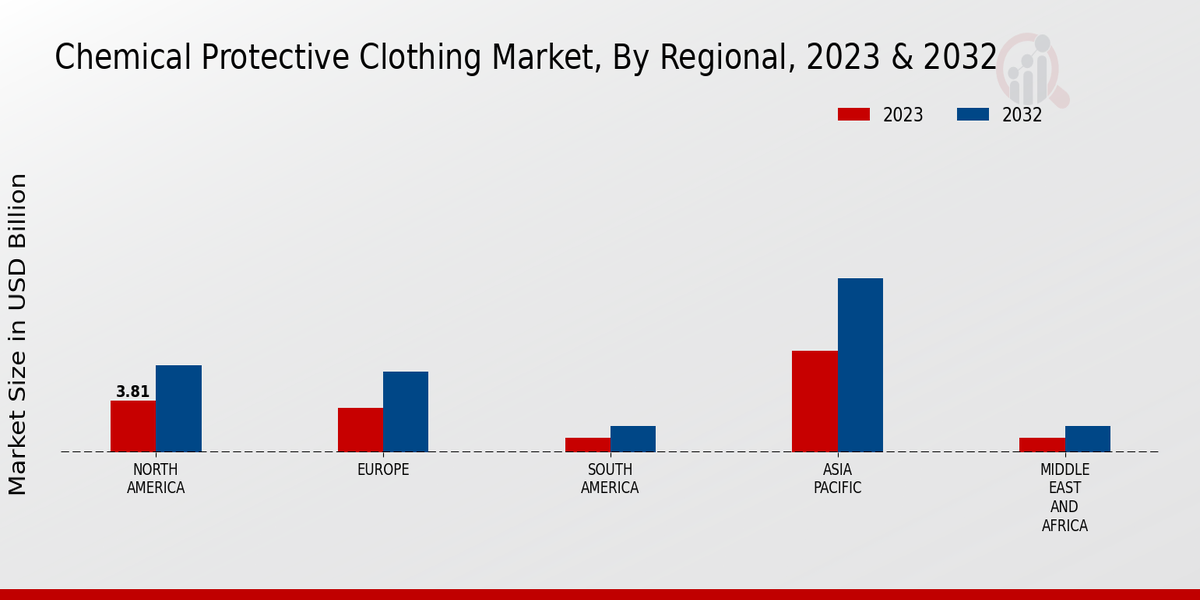Emerging Markets and Globalization
Emerging markets are increasingly contributing to the growth of the Global Chemical Protective Clothing Market Industry. As globalization facilitates the expansion of industries into developing regions, the demand for chemical protective clothing is rising. Countries in Asia, Africa, and Latin America are witnessing industrial growth, leading to a heightened focus on worker safety and compliance with international safety standards. This trend is likely to drive the market further, with projections indicating a market value of 23.8 USD Billion by 2035. The integration of global safety standards into local practices is expected to enhance the demand for protective clothing in these regions.
Market Trends and Growth Projections
The Global Chemical Protective Clothing Market Industry is characterized by various trends and growth projections that indicate a robust future. The market is anticipated to grow from 12.3 USD Billion in 2024 to 23.8 USD Billion by 2035, reflecting a compound annual growth rate (CAGR) of 6.15% from 2025 to 2035. This growth is driven by factors such as increasing industrial safety regulations, rising awareness of workplace safety, and advancements in fabric technology. The market is poised for expansion as industries continue to prioritize worker safety and compliance with evolving regulations.
Rising Awareness of Workplace Safety
There is a notable increase in awareness regarding workplace safety among employers and employees, which is significantly influencing the Global Chemical Protective Clothing Market Industry. Organizations are increasingly investing in protective clothing to mitigate risks associated with chemical exposure. This heightened awareness is driven by incidents of workplace accidents and the potential health implications of chemical exposure. As a result, companies are prioritizing the procurement of high-quality protective gear, leading to an expected market growth to 23.8 USD Billion by 2035. This trend indicates a long-term commitment to enhancing safety standards across various industries.
Growth in Chemical Manufacturing Sector
The expansion of the chemical manufacturing sector is a significant driver for the Global Chemical Protective Clothing Market Industry. As the production of chemicals increases, so does the need for protective clothing to ensure worker safety. The chemical industry is projected to continue its growth trajectory, necessitating the use of protective gear to comply with safety standards. This trend is particularly evident in regions with robust chemical production, such as North America and Asia-Pacific. The rising demand for chemical protective clothing is expected to contribute to the market reaching 12.3 USD Billion in 2024, with sustained growth anticipated as the sector evolves.
Increasing Industrial Safety Regulations
The Global Chemical Protective Clothing Market Industry is experiencing growth due to the increasing implementation of stringent safety regulations across various sectors. Governments worldwide are mandating the use of protective clothing to safeguard workers from hazardous materials. For instance, the Occupational Safety and Health Administration (OSHA) in the United States has established guidelines that necessitate the use of chemical protective gear in industries such as manufacturing and construction. This regulatory push is expected to drive market demand, contributing to a projected market value of 12.3 USD Billion in 2024, with further growth anticipated as regulations tighten.
Technological Advancements in Fabric Materials
Technological innovations in fabric materials are playing a crucial role in shaping the Global Chemical Protective Clothing Market Industry. Advancements in textile technology have led to the development of lighter, more durable, and breathable materials that offer enhanced protection against chemicals. For example, the introduction of nanotechnology in fabric production has resulted in garments that provide superior resistance to chemical permeation. These innovations not only improve comfort for the wearer but also expand the range of applications for chemical protective clothing. As a result, the market is expected to grow at a CAGR of 6.15% from 2025 to 2035, reflecting the impact of these advancements.






















Leave a Comment